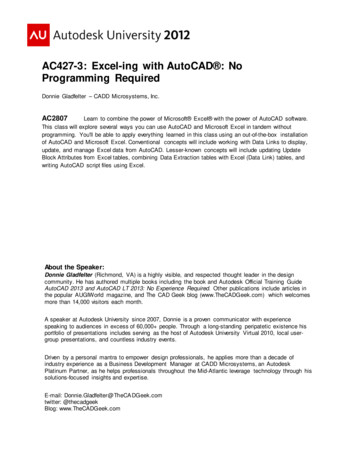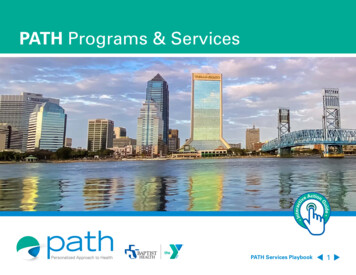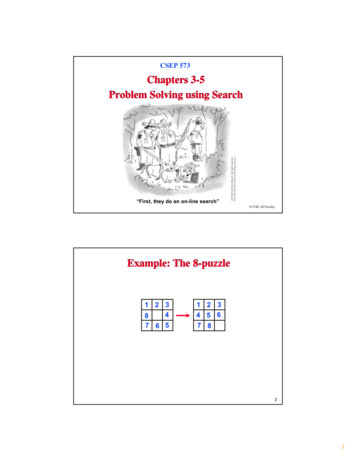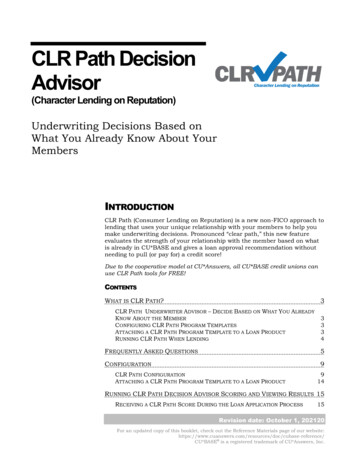
Transcription
FIND THE RIGHTCOLLEGE PATHA parent’s guide to selecting a college
2-year collegeJoin the militaryFull-time jobMANYOPTIONSWORTHEXPLORINGOptions abound foryour high school studentAttend a 4-year collegeThere is no shortage of options available to your childupon graduating high school. As you see in the image toLearn a tradethe left, your high school student has probably never hadso many paths to consider. The stakes have never beenhigher because of the high cost of education and the debtthat can smother students. An evolving economy opensnew pathways and opportunities to students who wantLaunch a businesshands-on, relevant and individual learning opportunities.This guide will help you discuss the options and provideimportant discussion tips. Once you know all the optionsyou and your child can customize a path that fits yourJoin Peace Corpschild’s interests and strengths, helping ensure successand happiness. You can go confidently, knowing there arealways on-roads and off-roads to on the path to success.average student debtTake a gap yearFOSTER A SHARED VISION OFOPPORTUNITIES FOR YOUR CHILD2A PARENT’S GUIDE TO COLLEGE OPTIONSWISTECHCOLLEGES.ORG
WISCONSIN’S 16 TECHNICAL COLLEGESMADISON COLLEGE800.322.6282NORTHEAST PPEWA VALLEY715.833.6300MID-STATE888.575.6782SOUTHWEST TECH800.362.3322cvtc.edumstc.eduswtc.eduFOX VALLEY800.735.FVTC (3882)MILWAUKEE AREA800.720.MATC (6282)WAUKESHA 00.247.7122MORAINE ark.eduwesterntc.eduLAKESHORE888.GO TO LTC (468.6582)NICOLET COLLEGE715.365.4493WISCONSIN INDIANHEAD800.243.WITC NTRAL888.682.7144For the hard of hearing711 EW COLLEGE LOCATIONSWISTECHCOLLEGES.ORG/MAPEvolving economy4Value of degrees6Career interest8Career pathwaysWISTECHCOLLEGES.ORG9Being an engaged parent10Making financial sense of college14Degree options18Transfer options20Planning timeline22Career optionsA PARENT’S GUIDE TO COLLEGE OPTIONS243
CHANGINGECONOMY CREATESNEW CAREERSEmployers are less concerned aboutdegrees and more concerned about skillsHigh-skill jobs, changing demand and worker shortages mean employers are looking to fill jobsquickly and with the right skills. For many employers, this new urgency requires them to useunique hiring techniques and revise their expectations.“Our employees have all been hired fromtechnical colleges. We find that they area perfect fit for our business, ready tohit the ground running,”— KATIE SEDLACEKI,HARRIS REBAR AMBASSADOR STEEL4A PARENT’S GUIDE TO COLLEGE OPTIONSWISTECHCOLLEGES.ORG
IT’S ABOUT SKILLSThe workplace and education demandscontinue to evolveMost companies today seek employees with specific skills and technical abilities. In fact, by about2020, about two-thirds of new jobs will require some college, a technical diploma, associate degreeor higher.* Because of the high cost of many educational options, students take on a lot of debt andstruggle to get ahead, while employers struggle to find employees with the specific skills they need.There are fewer workers in the pipeline while there is a glut of workers expecting to retire, leavinga vacuum of eligible job candidates.Employers struggling to find workers with skills in high-demand fields like information technology,construction, health care, manufacturing and many more, have tremendous opportunities forhigh-paying, fulfilling careers. Many opportunities exist for students preparing for careers througha technical college, where their education is likely to be practical and hands-on. An efficient andaffordable education fills jobs and saves tuition costs all at the same time. As technology changeswith increasing speed, there will always be opportunities to change paths or continue educationas needed.EMPLOYMENT GROWTH PROJECTIONS (BY DEGREE)Growth in employment by typical entry-level education, 2016-26TECHNICAL/COMMUNITY ��SThe Occupational Employment Statistics program, U.S. Bureau of Labor Statistics, updated April 2018.*Georgetown University, Center for Education and Workforce5%HIGH SCHOOL
ALL DEGREESHAVE VALUEEducation is the best investment in future successReturn on investment (ROI) is an important consideration in selecting a college. ROI varies mostbetween fields, NOT by levels of degree. For example, jobs in high demand where specific skills areboth highly valued and scarce by nature will pay more. Engineering and math degrees offer up toa 21 percent return while liberal arts offers up to 12 percent. Consider what careers and skills(versus what degree) might interest your child.WAGES SOMETIMES DEPEND ON THE AVAILABILITY OFWORKERS (AND SKILLS), NOT ON THE TYPE OF DEGREE.ENGINEERING AND MATHDEGREES OFFER UP TO ARET URNLIBERAL ARTS DEGREESOFFER UP TO ARET URNSource:Georgetown University, Center for Educationand Workforce6A PARENT’S GUIDE TO COLLEGE OPTIONSWISTECHCOLLEGES.ORG
54%SALARY GROWTH FORTECHNICAL COLLEGEGRADUATES IS HIGHERTHAN AVERAGEWherever your child’s interests or passionslie, chances are there are employers whoneed skilled workers. Generally, employersvalue technical college graduates and paygood salaries to attract and retain them.MEDIAN SALARYINCREASEOVER THE LAST5 YEARSSource:WTCS Five-Year Graduate Follow-up Report for Class of 2010,published December 2016.MEDIAN SALARY 6 MONTHS AFTERGRADUATION FOR ASSOCIATE DEGREES 42,803MEDIAN SALARY 6 MONTHS AFTERGRADUATION FOR ALL CREDENTIALS 38,529LAND A JOB AND HITTHE GROUND RUNNINGWith a hands-on, practical approach tolearning, a technical college education setsstudents up for success, not just in terms ofstarting salary and availability of jobs butalso in continued wage growth over time.Source:WTCS Graduate Outcomes Report for 2017 Graduates, published May 2018.GRADUATES ROUTINELYREPORT GOOD RESULTSFROM THEIR EXPERIENCEAND OVERALL RETURNON INVESTMENTWisconsin’s technical colleges partnerwith employers to ensure the educationstudents receive will match the needs ofthe employer. Student satisfaction withtheir education and working within theirfield demonstrates the relevance andquality of the education they receive.GRADUATES WHO FINDA JOB WITHIN SIX MONTHS94%GRADUATES WOULD RECOMMENDA TECHNICAL COLLEGE EDUCATION96%GRADUATES EMPLOYED IN A JOBRELATED TO THEIR TRAINING79%Source:WTCS Graduate Outcomes Report for 2017 Graduates, published May 2018.
THE CAREER YOURCHILD LOVESIS WAITING Encourage career explorationTAKE THE CAREERINTEREST QUESTIONNAIRE10 minutes is all it takes to see which careers match your child’s interests.The short online activity will also pay off by giving him or her a place tostart thinking about and discussing future career possibilities.EXPLORE YOUR CAREER PATHWISTECHCOLLEGES.ORG/CAREERS
PLANNINGFOR THE FUTUREBuild a career, one step at a timeIf your child knows where he or she wants to go but doesn’t know how to get there Career Pathways help make education more efficient.Students earn a credential with just a few courses, thenearn a more advanced certificate, degree or diplomaas they complete other related groups of courses.LIFELONG LEARNINGOPTIONS/PATHWAYSMAY INCLUDE:HIGH SCHOOLSTUDENTVETERAN ORMILITARY4-YEARTRANSFERSTUDENT ORGRADUATEHands-on Career Awareness, Exploration Dual Credit for High School Students Degrees, Diplomas & Certificates Industry-Based Certification Credit Transfer Youth Apprenticeship Earn college credit in high schoolMicrosoft, Automotive Service Excellence (ASE), American Welding SocietyCredit for Prior Learning, Liberal Arts Transfer and moreRegistered ApprenticeshipStudent Support ServicesAcademic and Financial Advising, Tutoring, Career Counseling and moreBridges to Occupational ProgramsHigh School Equivalency Diploma (HSED), General Education Development(GED), Adult Basic Education (ABE), English Language Learner (ELL)WISTECHCOLLEGES.ORGA PARENT’S GUIDE TO COLLEGE OPTIONS9
VISIT A TECHNICALCOLLEGE CAMPUSTALK WITH CURRENT STUDENTSOR RECENT GRADUATESENCOURAGE VOLUNTEEROPPORTUNITIESHOW CAN YOU BE AN ENGAGED PARENT?Take interest in your child’s hobbies and education.Visit a technical college campus.Talk with current students or recent graduates.Visit a university campus.Have your child job shadow a friend or relativeto see what they do for a day.the positives of the school; the beautifulcampus, the state-of-the-art equipmentand hands-on labs. The instructors aredirect from industry and promoted howOccasionally revisit the student’s interests.our son would learn real-world skillsEncourage volunteer opportunities.from industry professionals.Remember to focus on what your child wants to do.10We attended the open houses and sawA PARENT’S GUIDE TO COLLEGE OPTIONS— LAURIE C., PARENTWISTECHCOLLEGES.ORG
BEGINNING ADISCUSSIONIt can be difficult to begin a conversation about careers and higher education if it hasn’tbeen a natural topic of conversation for parents and children. Children often want toenjoy independence and parents often want to have some influence.Consider your child’s passions and hobbies, which are often a great basis fora career. Talk to her or him about how a hobby could translate into a career.Your child may not have a clear sense of direction. It may not appear to be a logicalchoice, but parents should be ready for their child to say, “It just feels right.”Value hype. Value means getting a high quality education without the high costassociated with some colleges and universities. The stress that comes with taking onhuge debt has longer lasting effects than short-lived pride associated with a brand.Discuss rather than dictate. Make suggestions and ask questions to help yourchild think about their options and be open to hearing what they have to say.Assume your children are capable of making this decision for themselves. Manyparents struggle with their child becoming independent, but they need tounderstand the child is directly affected by his or her own decisions.PARENTS WHO GIVE THEIR CHILDREN ROOM TO DISCOVERWHO THEY ARE — ON THEIR OWN TERMS — INCREASE THELIKELIHOOD FOR FUTURE CAREER HAPPINESS AND SUCCESS.The proximity of the school wasbeneficial, and they had the coursesthat she was looking for. I pointed outto my daughter that it was also lessexpensive to attend a technical schoolrather than a four-year college.— DANIEL P., PARENT
QUESTIONS TO HELP START THE DISCUSSIONAsk your child these questions to help determine which path is right for them:Do you know what you want to study?Do you desire large or small classes and campuses? Why?Do you envision working with your hands or more with people? Are you drawn more to learning through books and lectures or throughhands-on, practical experience?Have you had the opportunity to visit both two- and four-year collegesto see what they’re like?What financial resources do you have access to? Do you want the option of living at home?Do you want to move out and experience more independence?12A PARENT’S GUIDE TO COLLEGE OPTIONSWISTECHCOLLEGES.ORG
WHERE DOES YOUR CHILD’S PASSION A PARENT’S GUIDE TO COLLEGE OPTIONS13
MAKING FINANCIALSENSE OF COLLEGEThe facts tell the story: student debt is a growing problemUsing the U.S. Department of Education’s Repayment Estimator, the monthly payment on a directsubsidized loan for the average student debt would be 359/month for 10 years, for a total repaymentamount of 43,124. This amounts to 4,308 per year from your student’s earnings. Consider what elseyour child could do with that money (savings, transportation, rent, etc.). To avoid the big IOU, hereare some financial items to consider when selecting a college:The tuition amount doesn’t include the full cost associated with obtaining a degree, whichoften includes room and board, books, computers or tablets, food and transportation.One year of full-time student tuition at a Wisconsin Technical College is under 4,100. A student attending a local community or technical college can often live at home,saving thousands of dollars in room, board and travel.Technical college students have access to a wide range of scholarships and grants,just like students at other higher education institutions.Financial obstacles in my life made it hardto find a college that would help me obtaina degree. Enrolling at my technical collegegave me an opportunity to take advantageof college classes in a cost-efficient way.— KEYDI O., TECHNICAL COLLEGE STUDENT14A PARENT’S GUIDE TO COLLEGE OPTIONSWISTECHCOLLEGES.ORG
6/1077%TECHNICAL OR COMMUNITYCOLLEGE GRADUATES HAVEDEBTAT GRADUATIONSource:WTCS Five-Year Graduate Follow-up Report for Class of 2010,published December 2016.WISCONSINTECHNICALCOLLEGES 4,026*UW TWO-YEARINSTITUTIONS(includes fees)(includes fees)77%of ts AL AVERAGE COSTOF COLLEGE TUITION 5,186UW FOUR-YEARINSTITUTIONS, min.OF* WTCS tuition is set by the WisconsinTechnical College System Board in March for 7,389UW FOUR-YEARINSTITUTIONS, max.the following year. It does not include books,materials or program/college-related fees. 10,534(includes fees)ALL FOUR-YEAR INSTITUTIONS 30,180(AVERAGE PUBLIC OUT-OF-STATE AND PRIVATE NON-PROFIT, 2017-2018)Sources: WTCS Tuition Work Group; UW HELP System Tuition Chart, The College Board 2018, College Costs: FAQ'sFINANCIAL AID RESOURCESWISTECHCOLLEGES .ORG/FINANCIALAIDWISTECHCOLLEGES.ORGA PARENT’S GUIDE TO COLLEGE OPTIONS15
MAXIMIZE TIME,MINIMIZE DEBTConsider upfront cost as well as completion timeMany recent graduates are struggling to find work that pays off debt and provides the means to livea full life. A heart-to-heart chat with your child to determine the best path for him or her may resultin tremendous savings on education and possibly a bigger return on college investment, too.59%OF STUDENTS IN 4-YEAR PROGRAMSACTUALLY GRADUATE IN 6 YEARSSource:WTCS Five-Year Graduate Follow-up Report for Class of 2010, published December 2016.A bachelor’s degree, while often referred to as a four-year degree, can take five or six years for manystudents to complete. A technical education is focused on practical, hands-on skills development, so thedegrees generally require two years of full-time enrollment or less. Technical degrees and diplomasare ideal for students who want to work in highly technical professions like health care or informationtechnology, for example. Given how technology continues to change employers’ workforce needs,technical certificates, diplomas and degrees make great options for students to continue theireducation by taking small stacks of credits over time as needed.16A PARENT’S GUIDE TO COLLEGE OPTIONSWISTECHCOLLEGES.ORG
GET A HEAD STARTCollege-level courses could begin in high school(saving hundreds in future tuition costs)By planning ahead, students can earn high school and college credits at the same time, shorteningtime to a degree and reducing overall costs. Here are some ways to get a head start in high school:YOUTH APPRENTICESHIPYouth apprenticeship combines school and technical instruction with mentored, paid, on-the-joblearning. Students can enroll in college classes to meet high school graduation requirements.Youth apprenticeship students take a class and work for a participating employer under thesupervision of a skilled mentor.DUAL CREDITDual credit provides opportunities for high school students to take college-level courseworkwhile in high school to get a head start. Students earn college credits (at no cost to them)while continuing to fulfill high school graduation requirements.ADVANCED STANDING AND TRANSCRIPTED CREDITThese options align high school coursework to college-level coursework, or providecollege-level coursework in high school.START COLLEGE NOW (FORMERLY YOUTH OPTIONS)With school board approval, high school juniors and seniors may take courses ata technical college that are not offered in high school.EARN COLLEGE CREDITS IN HIGH SCHOOLWI S T E C H CO L L E G E S .O R G / P R E PA R EWISTECHCOLLEGES.ORGA PARENT’S GUIDE TO COLLEGE OPTIONS17
KNOW ALLTHE OPTIONSResearch all the options to get the most rewardsMany adults settle for a low-skill job or no job at all because their education may not match theskills employers need. Meanwhile, good-paying jobs and apprenticeships requiring a two-yeardegree and/or technical skills sit vacant. This changing job market allows a lot of flexibilityand promotion for people with the right skills.With over 500 career programs to choose from, technical college students can receive an associatedegree or another degree such as a one- or two-year technical diploma, short-term diploma/certificate or an apprenticeship with an employer sponsorship.CERTIFICATE (typically six months or less)Entry-level credential for quick employment gainsTECHNICAL DIPLOMA (one- to two-year programs)Real-world programs created with employer inputTypically one to two years to complete full timeASSOCIATE DEGREE (two-year programs)Academic degree with a focus on hard and soft skillsTypically two years to complete full timeMay build on earlier credentials (certificates, degrees and diplomas)APPRENTICESHIP (journey worker or a skilled, registered trades person)Employers pay for supervised, structured on-the-job training and classroom learningPrepares skilled tradespeople to enter the workforce (with a median salary of 77,753/year six months after completion)Visit wistechcolleges.org/apprenticeship for more information18A PARENT’S GUIDE TO COLLEGE OPTIONSWISTECHCOLLEGES.ORG
IF YOU ONLYREAD THIS!Please consider these important but sometimesoverlooked facts about technical college experienceand student lifeSeveral of Wisconsin’s technical colleges offer dorms for students who want to live on campus.Athletics are available through either intra- or extramural teams or through the National JuniorCollege Athletic Association (NJCAA) at many Wisconsin technical colleges.Contrary to popular belief, many technical college programs are eligible for financial aid.There are many ways for technical college students to be active around campus throughprofessional groups and clubs, honor societies or student government. These activities are agreat way to connect with fellow students, develop leadership and other skills employers want.Apprenticeships provide opportunities for students in the trades (as well as in other areas),that employers sponsor. Students get paid for time spent in class and on-the-job training.Technical colleges offer technology and services available to students, including cafeterias,student lounges, daycare centers, job placement centers and library resources to name a few.98% of Wisconsin’s employers surveyed said a technical college was important to the overallsuccess of their business.WISTECHCOLLEGES.ORGA PARENT’S GUIDE TO COLLEGE OPTIONS19
TRANSFER OPTIONSIf your child’s goal is to earn a bachelor’s degree orhigher, they can begin their education journey ata technical college and spend less overallStudents can start with a short-term or two-year program and end with a bachelor’s degree or more.INStudents in a four-year university or college can also transfer to one of Wisconsin's technical colleges.TRANSFER CREDITS TOA TECHNICAL COLLEGEStudents who previously attended another postsecondary institution may beable to transfer credits or receive credit for skills and knowledge earned.WAYS TO TRANSFER TO A UNIVERSITYPROGRAM-TO-PROGRAM TRANSFER AGREEMENTSAll 16 technical colleges have program-specific transfer agreements with four-yearOUTprivate colleges and universities and the University of Wisconsin System.UNIVERSAL CREDIT TRANSFER AGREEMENTAllows for roughly a year's worth of general credits taken at our technicalcolleges to seamlessly apply toward a bachelor's degree.LIBERAL ARTS COLLEGE TRANSFER PROGRAMFive of Wisconsin’s 16 technical colleges have Liberal Arts Transfer programs, providingthe first two years of a bachelor's degree transferable to many four-year universities:Chippewa Valley Technical College, Madison College, Milwaukee AreaTechnical College, Nicolet College, Western Technical College.20A PARENT’S GUIDE TO COLLEGE OPTIONSWISTECHCOLLEGES.ORG
018Sept.2:WceurSoTCSCredit Transfeerel-17,r Report 2016asedLEARN ABOUT TRANSFER OPTIONSWISTECHCOLLEGES .ORG/ TRANSFERWISTECHCOLLEGES.ORGA PARENT’S GUIDE TO COLLEGE OPTIONS21
WHAT’S NEXT?It’s never too early to think about futurecareers and the steps needed to get thereIt’s important for your child to consider how decisions they make about courses they take, extracurricular activities and time spent could impact their future. As parents, you can help guide thediscussion. The following time line might also be helpful to guide your child through some importantactivities along their path. If your child is already past all these points, don’t fret! Wisconsin’stechnical colleges can walk you both through the next steps of evaluating college options.Even without advanced preparation, attending a technical college is one of the best waysto get a high quality, in-demand and fulfilling education and come out ahead financially.MIDDLE SCHOOL/ONGOINGTake this online career interest questionnaire to help identify skills, strengths and interests:wistechcolleges.org/careersThink about your future career with your Academic & Career Plan (ACP) and visit thesesites to learn more about different careers:MY NEXT MOVE mynextmove.orgCAREER PATHWAYS wicareerpathways.orgBIG FUTURE bigfuture.collegeboard.org/explore-careersEXPLORE CAREERS – CAREER ONE STOP careeronestop.org/explorecareersCAREER QUESTIONNAIRE wistechcolleges.org/careersFRESHMAN YEARTry some extracurricular activities and see what interests youDiscuss college and career interests with school counselors; ask about taking collegecourses while in high schoolTalk to people about their jobs – What do they do? What do they like about their job? Whatother careers did they consider?Learn and practice good study habits to carry on to college. Figure out how you learn bestso you can maximize your effortChoose courses matching your interests and abilities and that relate to potential careersObserve jobs around you; especially new or unusual jobs to help narrow your options22A PARENT’S GUIDE TO COLLEGE OPTIONSWISTECHCOLLEGES.ORG
SOPHOMORE YEARDiscuss college with your parents. Talk about yourinterests and the opportunities ahead of youBegin talking about how you might pay for college andwhat scholarships, grants and loans might be availableGet active in clubs and other volunteer activities —you can list them on your college applicationMeet with your school counselor to discuss dualcredit optionsConnect with people in various fields of interest for interviewing or job shadowingMake a list of what you would look for in a college (e.g. programs, class size, cost)JUNIOR YEARAre you interested in health care, IT, education, manufacturing, public safety? Learn whatcollege majors fall under each cluster/industry (view the career options on the next fewpages to give you an idea of some possibilities)Apply for high school/college credit programs in fall; Youth Apprenticeships provide jobskills and college creditStart planning for admissions testing including the ACT, SAT testsVisit collegegoalwi.org, then attend a College Goal Wisconsin event in fall for assistancecompleting the Free Application for Federal Student Aid (FAFSA)Pursue summer jobs, internships or job shadowsStart to narrow your list of college choicesSchedule campus visits; try to visit a variety of colleges so you know how they varyNote application and scholarship deadlines on a calendar to help stay on trackSENIOR YEARTalk to people about their careers and see if you can job shadow or volunteer with peers,family and business ownersPlan to take the college admissions tests that your potential colleges acceptApply to college in fall if you haven’t alreadyApply for scholarshipsVisit the FAFSA website, fafsa.gov to find out what you need to complete the formWISTECHCOLLEGES.ORGA PARENT’S GUIDE TO COLLEGE OPTIONS23
or clients.illness, improvequality of life.TIONSCAREER OPTIONSJOBS IN THEISTANTHEALTH FIELDS WILLDENTAL HYGIENISTCONTINUE TO BEDIETARY MANAGERIN DEMAND AS BABYCESBOOMERS AGE ANDREQUIRE MOREEARCHERentertain othersexpertly.ENTREPRENEURIALBANQUET AND CATERING MANAGEROPPORTUNITIESEVENT PLANNERAS WELL AS THENURSINGHOTEL MANAGERCHANCE TO WORKPHARMACY TECHNICIANCARE.CAREER OPTIONSTHERE ARE MANYRADIOGRAPHYFOR SOME OF THEPASTRY CHEFFINEST HOSPITALITYRESTAURANT CHEFORGANIZATIONS.LAW, PUBLICSAFETY &SECURITYmingtworksHelp maintainsafety and order inour communities.NSTHE MEDIAN STARTINGSALARY FOR PUBLICSAFETY tLOGY,TEM)gy andkeepng.ONSECHNOLOGYMake, invent orassemble goods.CAREER OPTIONSCAREER OPTIONSAUTOMATED SYSTEMS TECHNICIANTHE MEDIANFORENSIC SCIENCEALS IS OVER 41,000FIRE PROTECTION TECHNICIANSIX MONTHS AFTEREMT-PARAMEDICSTARTING SALARYIN MANUFACTURINGFOR ASSOCIATECNC OPERATORMACHINISTSAFETY ENGINEERDO WHAT YOU LOVEGRADUATION.Source: 2017 GraduateOutcomes ReportDEGREE HOLDERSPARAMEDIC TECHNICIANIS NEARLY 48,000LAW ENFORCEMENTSIX MONTHS AFTERGRADUATION.Love what you do!WELDERSource: 2017 Graduate Outcomes Report 77,753ANNUAL MEDIAN SALARYAs you and your child explore educationTRANSPORTATION,options, be aware there are many differentDISTRIBUTIONcareers available in a widerange of fields& LOGISTICS(and transfer opportunities too!).APPRENTICESHIPManage thetransfer of goods.Learn a trade whileyou earn your way.The following pages depict justa fewOPTIONSCAREERTRUCK DRIVINGAIRPLANEMECHANICexamples THEof careersamong themanyPROGRAM ISAUTOMOTIVE MECHANICdegree inprofessions. A technical collegeSUPPLY CHAIN MANAGERRING TECHNOLOGYLOGYMANUFACTURINGUSUALLY UNDERCAREER OPTIONSTHE MEDIANANNUALSALARY ONEARBORISTCOSMETOLOGYONE-YEAR, BUT THEYEAR AFTERELECTRICAL CONSTRUCTIONCOMPLETIONHEAVY EQUIPMENT OPERATOR 46,000 SIXIS 77,753.MEDIANSALARYTRUCK DRIVERone of theseareaswillIShelp prepareyour childfor the future. He or she will learnthe skillsSource: 2017 Graduate Outcomes ReportMONTHS AFTERGRADUATION.needed for in-demand careers in this ever-Source: WTCS ApprenticeshipCompletion Report 2016-17,published January 2019INFORMATION TECHNOLOGYMECHATRONICSPLUMBINGchanging economy and the confidenceto pursue a career they love.TRANFERPROGRAMSSkills that we acquire through the apprenticeship program really help us build abetter foundation so we are more valuable to employers and to the community.— JESSICA C., MILESTONE PLUMBING INC.,credits transfer intoTECHNICAL COLLEGE ManySTUDENTfour-year degree programs.This is an affordable way to
LOVE»ELOVEDO WHATWHAT DNATURALRESOURCESRESOURCESSo Sour ONSCAREEROPTIONSAGRICULTUREAGRICULTUREMAKESUP UP12%12%MAKESAGRIBUSINESS,SCIENCE& TECHNOLOGYAGRIBUSINESS,SCIENCE& TECHNOLOGYAGRICULTUREEQUIPMENT& MECHANICSAGRICULTUREEQUIPMENT& MECHANICSOF ICULTURE& LANDSCAPINGHORTICULTURE& .AGRICULTUREAGRICULTUREAGRIBUSINESS,SCIENCE& TECHNOLOGYAGRIBUSINESS,SCIENCE& AREEROPTIONSMAKES12%MAKESUP UP12%THISFIELDREQUIRESA A AGRICULTURETHISFIELDREQUIRESAGRICULTUREEQUIPMENT& MECHANICSEQUIPMENT& AL MEDIA DESIGNWISCONSIN’SOF OFWISCONSIN’SDEDICATIONTO MATIONGAMING&ANIMATION SERVICESPEOPLEANDA T’S413,500ANIMALSCIENCE,LIVESTOCK& DAIRYSCIENCE,LIVESTOCK& ELPINGPASSIONFORHELPING DIANJOBS!JOBS!THEMACHIEVEGOALS,THEMACHIEVEGOALS, FARMFARMBUSINESS& MANAGEMENTBUSINESS& MANAGEMENTSALARYOF 43,300SALARYOF OVETHEIRSIXMONTHSAFTERSIXMONTHSAFTERHORTICULTURE& LANDSCAPINGHORTICULTURE& LANDSCAPINGPHOTOGRAPHYPHOTOGRAPHYABILITIESANDDO inDepartmentof Agriculture,Source:WisconsinDepartmentof Agriculture,THEIRBEST.THEIRBEST.Tradeand ConsumerProtection,updated2/16/18Tradeand DUCATIONEDUCATION&TRAININGTRAINING& STHISFIELDREQUIRESA A LIBRARY& INFORMATIONSERVICESLIBRARY& INFORMATIONSERVICESBARBER/COSMETOLO
madisoncollege.edu MID-STATE 888.575.6782 mstc.edu MILWAUKEE AREA 800.720.MATC (6282) matc.edu morainepark.edu nicoletcollege.edu NORTHCENTRAL 888.682.7144 ntc.edu NORTHEAST WISCONSIN 888.385.6982 nwtc.edu SOUTHWEST TECH 800.362.3322 swtc.edu WAUKESHA COUNTY wctc.edu WESTERN 800.322.9982 westerntc.edu WISCONSIN INDIANHEAD 800.243.WITC (9482 .











